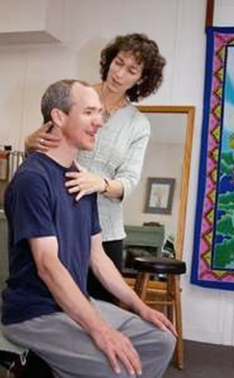
By Heather Stringer
Monday February 13, 2012 Excerpt on the Alexander Technique Interview with Idelle Packer, MS, PT,
certified teacher of the Alexander Technique
|
|
Idelle Packer, PT, helps patient Tommy Millsaps with his back pain. Alexander Technique The Alexander Technique is another approach that aims to change the way people move their entire bodies to alleviate pain in a specific area. The principles of the technique were developed in the 1890s by Frederick Matthias Alexander, a Shakespearean orator who suffered from voice loss during his performances. Physicians could not find a cause for his malady, and he discovered the technique as a way to alleviate his problems.
Idelle Packer, MS, PT, learned about the technique after she was injured in a car accident, which jeopardized her career as a professional dancer. "Little by little, I started learning how to organize my own movements to avoid nerve pain," said Packer, owner of Body Sense in Ashville, N.C.
Packer completed a three-year training program to become certified to teach the Alexander Technique, and several years later she returned to school to study physical therapy to gain the medical background she felt she needed to handle complex cases.
"The Alexander Technique taught me how to observe a patient's habitual muscular and postural movement patterns and analyze where they exhibited excess tension and compression," she said. "I teach patients to think before they move, because this awareness can help them avoid harmful positions." |
Packer recalled a patient in his 50s who had suffered from chronic back pain since he had played rugby as a teen. She
observed the man as he stood up from a seated position and noticed his back was slumped as he sat. As a result, his chin
jutted forward as he lurched forward to stand up. When she asked him to lie down in his preferred sleeping posture, she observed
his back was curled forward in the fetal position — similar to the hunch in his seated slump. She explained to the patient how his
movement patterns were putting a sustained posterior force on his discs, and she guided him into a preferred sitting position. With
gentle manual cues at his neck, she asked him to release the tension in his neck, and she guided his head upward.Then she
directed his knees so his thighs were moving away from the pelvis in a more neutral position, and as a result his back was not as
prone to slump.
After seven sessions, the man knew how to apply the postural principles of the Alexander Technique while working at a computer,
sleeping, walking and swimming. He also applied them while performing prescribed physical therapy exercises at home for back
mobility and strength. With these simple adjustments in posture, his back pain decreased dramatically.
"Awareness produces change," Packer said. "Patients learn new coordination patterns that change the way they function, and this
changes their structure. They are often surprised when they wake up without pain."
Although studying alternative therapies may require extra time and energy up front, Packer, Malmborg-O'Kelley and Boekmann
said the benefits of the additional training are obvious when they witness progress in patients who had resigned themselves to
lives of chronic back pain. "By having both Alexander and PT training, I can assess with physical therapy criteria through an
Alexander lens," Packer said. "I can teach patients the technique and then also use other modalities to help, such as electrical
stimulation and the cold pack. It is remarkable to have so many tools at my disposal. I have helped many people who have seen
an array of different practitioners with minimal results, and I give them hope again."
To view unabridged article: Click Here
Heather Stringer is a freelance writer. Share your thoughts: editor@TodayinPT.com
